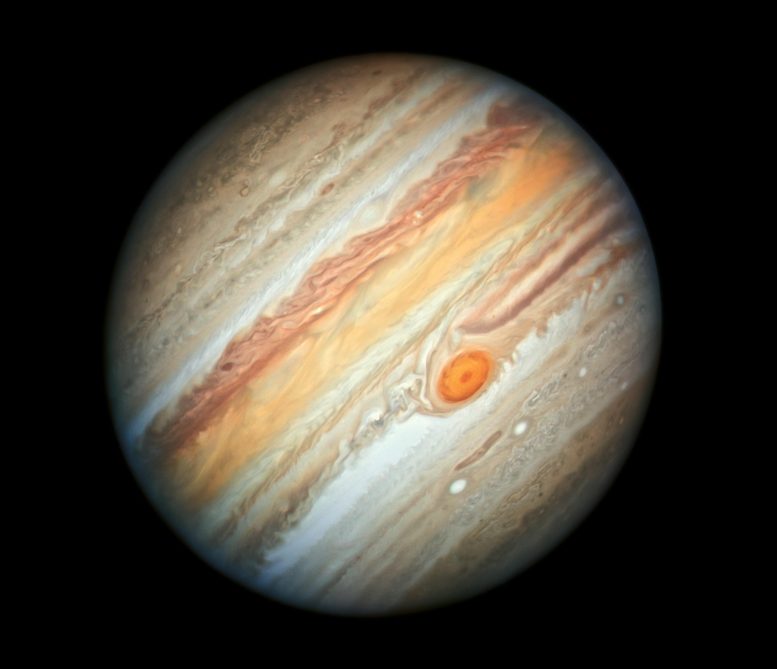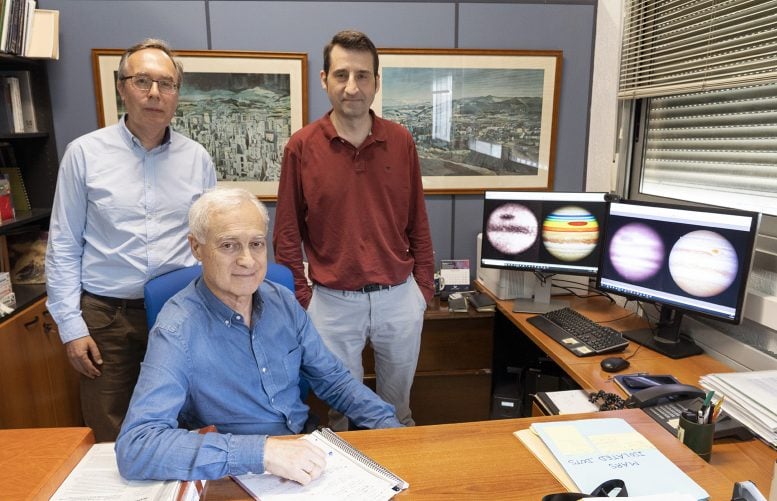
ThursdayWinn’s Great Red Spot is a giant spiral that has existed for at least 190 years. Recent studies suggest it is different from what was previously observed, and simulations explore how Jupiter’s wind may have shaped it. The GRS is shrinking, and future research will focus on its stability and future degradation.
Jupiter’s Great Red Spot (GRS) is one of the most iconic features of the Solar System. This massive atmospheric system, now about the same diameter as Earth, is easily recognizable due to its reddish hue that contrasts sharply with Jupiter’s pale cloud tops. Even small binoculars can capture its unique appearance. The GRS is a giant anticyclonic eddy with wind speeds of up to 450 km/h on its outer edges. It holds the title of being the largest and longest-lived eddy in the atmosphere of any planet in our solar system. However, the exact age of the GRS is still debated, and the processes behind its formation remain a mystery.
Speculations about the origin of the GRS date back to the first telescope observations made by astronomer Giovanni Domenico. CassiniIn 1665 he discovered a dark oval at the same latitude as GRS and named it 'permanent spot’ (PS) as he and other astronomers observed it until 1713.
Its trail was lost 118 years later. It was not until 1831 and later years that S. Schwabe again saw a clear structure, roughly oval in shape and at the same latitude as the GRS; This can be considered the first observation of the current GRS, perhaps a new GRS. Since then, the GRS has been continuously monitored by telescopes and by the various spacecraft that have visited the planet to date.
Analyzing the evolution of GRS
In the study, the authors first analyzed its size evolution over time, its structure and the movements of two meteorological systems, the former PS and GRS; To do so, they used historical sources dating back to the mid-17th century, shortly after the invention of the telescope.

„From measurements of magnitudes and motions, we found that the current GRS is unlikely to be the PS observed by GT Cassini. The PS probably disappeared between the 18th and mid-19th centuries, in which case we can say that the lifetime of the red spot is at least longer than 190 years,” said UPV/EHU and Augustin Sanchez-Laveca, professor of physics, explained. who led this research. The Red Spot, which was 39,000 km along its longest axis in 1879, has shrunk to its current 14,000 km and simultaneously become rounder.
Recent findings and simulation studies
What’s more, several space missions since the 1970s have closely studied this weather phenomenon. Recently, „various instruments aboard the Juno mission in orbit around Jupiter have shown that the GRS is shallow and thin compared to its horizontal dimension, because vertically it is about 500 km long,” explained Sánchez-LaVega.
To find out how this giant eddy might have developed, the UPV/EHU and UPC teams carried out numerical simulations using two types of complementary models on Spanish supercomputers such as BSC’s MareNostrum IV, part of the Spanish Supercomputing Network (RES). Behavior of thin eddies in Jupiter’s atmosphere. Dominant on the giant planet are intense wind currents that alternate in their direction with latitude and flow along the parallels. North of the GRS, winds blow in the westerly direction at a speed of 180 km/h, and in the south, they blow in the opposite direction, in an easterly direction, at a speed of 150 km/h. This creates a large north-south shear in wind speed, a basic ingredient that helps the vortex grow inside it.
The research explored various mechanisms to explain the origin of the GRS, including the eruption of a giant superstorm, as is rarely seen on a binary planet. Sator a conjunction of many small vortices produced by wind shear. The results indicate that although an anticyclone forms in both cases, it differs from the current GRS in terms of shape and dynamical characteristics. „If one of these unusual events had occurred, it or its effects on the atmosphere should have been observed and reported by astronomers at the time,” Sánchez-LaVega said.
Numerical simulations and future research
In a third set of experiments, the research team investigated the formation of GRS from a known instability in air that is thought to be capable of forming an elongated cell. Such a cell would be a proto-GRS, a new red dot, whose subsequent contraction would lead to the compact and rapidly rotating GRS observed in the late 19th century. The formation of large elongated cells has already been observed at the origin of other large gyres on Jupiter.
„In our simulations, the supercomputers enabled us to find that GRS are stable as they rotate around the circumference of Jupiter’s wind, which is expected when they form because of this instability,” said Enrique García-Melendo. , researcher at UPC’s Department of Physics. Using two different types of numerical models, one at UPV/EHU and the other at UPC, the researchers concluded that if the rotation speed of the proto-GRS was lower than the surrounding air, the proto-GRS would break up. , the formation of a stable vortex is impossible. Also, if it is too high, the proto-GRS characteristics differ from the current GRS.
Future research will attempt to reproduce the contraction of the GRS over time to explore in more detail the physical mechanisms underlying its persistence over time. At the same time, it will try to predict whether the GRS will decay and disappear when it reaches a size limit, as Cassini’s PS did, or whether it will stabilize at a size range that lasts for many years. .
Reference: Agustin Sánchez-Laveca, Enrique García-Melendo, John Legarreta, Arnau Miró, Manel Soria, and Kevin Ahrens-Velasquez, 16 June 2024, “The Origin of Jupiter’s Great Red Spot” Geophysical Research Letters.
DOI: 10.1029/2024GL108993

„Oddany rozwiązywacz problemów. Przyjazny hipsterom praktykant bekonu. Miłośnik kawy. Nieuleczalny introwertyk. Student.
